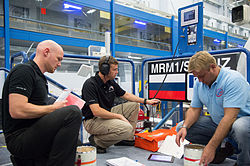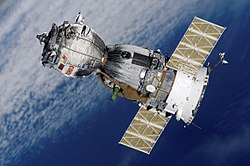 Soyuz TMA-13M docked to the ISS, flying above California and Nevada. | |
| Operator | Roscosmos |
|---|---|
| COSPAR ID | 2014-031A |
| SATCAT no. | 39775 |
| Mission duration | 165 days, 8 hours, 1 minute |
| Spacecraft properties | |
| Spacecraft | Soyuz 11F732A47 No.713 |
| Spacecraft type | Soyuz-TMA 11F747 |
| Manufacturer | Energia |
| Launch mass | 305,000 Kilograms |
| Crew | |
| Crew size | 3 |
| Members | Maksim Surayev Gregory R. Wiseman Alexander Gerst |
| Callsign | Cepheus |
| Start of mission | |
| Launch date | 28 May 2014, 19:57:41 UTC |
| Rocket | Soyuz-FG |
| Launch site | Baikonur 1/5 |
| End of mission | |
| Landing date | 10 November 2014, 03:58 UTC |
| Landing site | Kazakh Steppe, Kazakhstan |
| Orbital parameters | |
| Reference system | Geocentric |
| Regime | Low Earth |
| Docking with ISS | |
| Docking port | Rassvet nadir |
| Docking date | 29 May 2014 01:44 UTC |
| Undocking date | 10 November 2014 00:31 UTC [1] |
| Time docked | 164 days, 22 hours, 47 minutes |
 (l-r) Gerst, Wiseman and Surayev Soyuz programme (Crewed missions) | |
Soyuz TMA-13M was a 2014 flight to the International Space Station. It transported three members of the Expedition 40 crew to the International Space Station. TMA-13M was the 122nd flight of a Soyuz spacecraft since 1967, and the 39th Soyuz mission to the ISS. The Soyuz remained docked to the space station for the Expedition 41 increment to serve as an emergency escape vehicle until its departure in November 2014.




